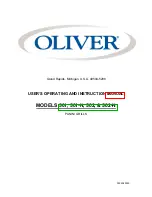
11 of 38
Copyright 2015 by Southern Pride Distributing, LLC Volume 1
GAS PIPING INSTRUCTIONS
IMPORTANT NOTES TO THE INSTALLER
Read all instructions contained in this Owner’s Manual before making gas connections.
Ensure all packing material is removed from the smoker compartments before connecting the gas supply to
the smoker.
Be sure your smoker is installed and grounded properly by a qualified service technician.
Observe all governing codes and ordinances.
WARNING: IMPROPER GAS HOOKUP WILL VOID WARRANTY AND COULD RESULT IN A
HAZARDOUS CONDITION.
1. All local and national codes and ordinances must be observed. Installation must conform with local codes
or in the absence of codes, the National Fuel Gas Code ANSI Z223.1 / NFPA-54, latest edition available
from The American Gas Association, Inc., 1515 Wilson Boulevard, Arlington, VA 22209.
2. The gas supply (service) line must be the same size or greater than the inlet line of the appliance. This
smoker uses a 1/2” (1.3 cm) ID NPT (Sch40) inlet. Sealant on all pipe joints must be resistive to LP gas.
3. Supply line and manifold pressure should be checked with a manometer. Refer to page 16 for minimum
and maximum pressures. Incoming line pressure upstream from the regulator must be 1” W.C.P. higher
than the manifold pressure in order to check the regulator. The regulator used on this smoker can withstand
a maximum input pressure of 1/2” PSI (14.0” W.C.P.). Over pressuring the valve may cause damage to the
valve. If the line pressure is in excess of that amount, a step down regulator will be required.
4. It is recommended new pipe be used and located so that a minimum amount of work will be required in
future servicing. The piping should be so installed as to be durable, substantial, and gas tight. It should be
free from cutting burrs and defects in structure and threading. Cast iron fittings or aluminum tubing should
not be used for the main gas circuit. Joint compounds (pipe dope) should be used sparingly on male threads
only and be approved for all gases.
NOTE:
The building structure should not be weakened by installation of the gas piping. The piping
should not be supported by other piping, but should be firmly supported by pipe hooks, straps, bands,
or hangers. Butt or lap welded pipe should not be bent.
5.
TEST PIPING FOR LEAKS.
Before turning gas under pressure into piping, all openings from which gas
can escape must be closed. Immediately after turning on gas, the system should be checked for leaks. This
can be done by watching the 1/2 cubic foot test dial for 5 minutes to show any movement, or by soaping
each pipe connection and watching for bubbles. If a leak is found, make the necessary repairs and repeat
the above test.
NOTE:
Defective pipes or fittings should be replaced and not repaired. Never use a flame or fire of
any form to locate gas leaks, use a soap solution.
6. After the piping and meter have been checked completely,
PURGE THE SYSTEM OF AIR. DO NOT
bleed the air inside the smoker. Be sure to relight all the gas pilots on other appliances.
NOTE:
The burner and its individual shutoff valve must be disconnected from the gas supply piping
system during any pressure testing in excess of 1/2 psig.












































